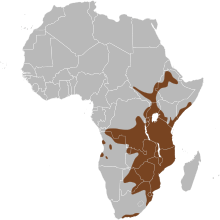Bushpig
- "Bush pig" may also refer to the red river hog.
| Bushpig | |
|---|---|
 | |
| Southern bushpig (P. larvatus koiropotamus) at the San Diego Zoo | |
| Scientific classification | |
| Kingdom: | Animalia |
| Phylum: | Chordata |
| Class: | Mammalia |
| Order: | Artiodactyla |
| Family: | Suidae |
| Subfamily: | Suinae |
| Genus: | Potamochoerus |
| Species: | P. larvatus |
| Binomial name | |
| Potamochoerus larvatus (F. Cuvier, 1822) | |
 | |
The bushpig (Potamochoerus larvatus) is a member of the pig family and lives in forests, woodland, riverine vegetation and reedbeds in East and Southern Africa. Probably introduced populations are also present in Madagascar. There have also been unverified reports of their presence on the Comoro island of Mayotte. Bushpigs are mainly nocturnal. There are several subspecies.
Adult bushpigs stand from 66 to 100 cm (26 to 39 in) at the shoulder, and weigh from 55 to 150 kg (121 to 331 lb).[2] They resemble the domestic pig, and can be identified by their blunt, muscular snouts, small eyes, pointed, tufted ears and buckled toes. Their colour varies from reddish brown to dark brown and becomes darker with age. Both sexes have a lighter-coloured mane which bristles when the animal becomes agitated. The upper parts of the face and ears are also lighter in colour. Their sharp tusks are fairly short and inconspicuous. Unlike warthogs, bushpigs run with their tails down. Males are normally larger than females.
The bushpig is closely related to the red river hog, Potamochoerus porcus, with which it can interbreed. The bushpig is distinguished by its less colourful markings, coarser hair, and larger size. Many pig populations display physical characteristics intermediate between the two species.
Bushpigs are quite social animals and are found in sounders of up to 12 members. A typical group will consist of a dominant male and a dominant female, with other females and juveniles accounting for the rest. Litters of three to four young are born in summer after a gestation period of approximately four months. Bushpigs can be very aggressive, especially when they have young.
They are omnivorous and their diet could include roots, crops or carrion. They grunt softly while foraging, and make a long, resonant growl as an alarm call. They are a significant nuisance in the agricultural regions of South Africa, and are hunted fairly extensively. However, the population of bushpigs in the farming areas continues to grow despite the hunting efforts, due to the largely inaccessible terrain, abundance of food, lack of predators, and their rapid ability to adapt to hunting methods. In Islamic parts of East Africa, it is a further nuisance because, as it is a pig, it is not permitted to be eaten. Its meat is considerably leaner than pork.
Still distributed over a wide range, the bushpig occurs from Ethiopia and Somalia to eastern and southern DR Congo and southwards to Cape and KwaZulu-Natal Province in South Africa,.[2] It also occurs on Madagascar and possibly the Comoros archipelago. It is not known how it reached these islands, but it was probably taken there by humans, possibly after a period of domestication.[3]
Subspecies include:[4]
- Potamochoerus larvatus larvatus (Madagascar bushpig)
- Potamochoerus larvatus edwardsi (Edwards' bushpig)
- Potamochoerus larvatus hassama (White-faced bushpig)
- Potamochoerus larvatus koiropotamus (Southern bushpig)
- Potamochoerus larvatus nyasae (Nyasan bushpig)
- Potamochoerus larvatus somaliensis (Somalian bushpig)
| Wikimedia Commons has media related to Potamochoerus larvatus. |
References
- ↑ Seydack. A. (2008). "Potamochoerus larvatus". IUCN Red List of Threatened Species. Version 2008. International Union for Conservation of Nature. Retrieved 5 April 2009. Database entry includes a brief justification of why this species is of least concern.
- 1 2 Kingdon, J. (1997). The Kingdon Guide to African Mammals. Academic Press Limited, London. ISBN 0-12-408355-2
- ↑ Simoons (1953), cited in Wilson, D.E.; Reeder, D.M., eds. (2005). Mammal Species of the World: A Taxonomic and Geographic Reference (3rd ed.). Johns Hopkins University Press. ISBN 978-0-8018-8221-0. OCLC 62265494.
- ↑ Wilson, D.E.; Reeder, D.M., eds. (2005). Mammal Species of the World: A Taxonomic and Geographic Reference (3rd ed.). Johns Hopkins University Press. ISBN 978-0-8018-8221-0. OCLC 62265494.
| Wikispecies has information related to: Potamochoerus larvatus |
External links
- Potamochoerus larvatus, Bushpig, Animal Diversity Web
- Potamochoerus larvatus, Bushpig, www.ultimateungulate.com
